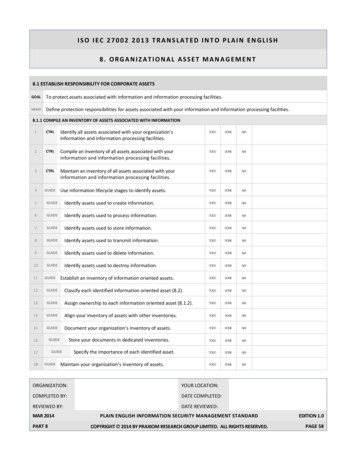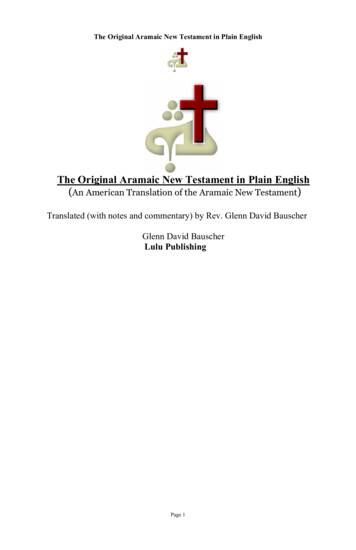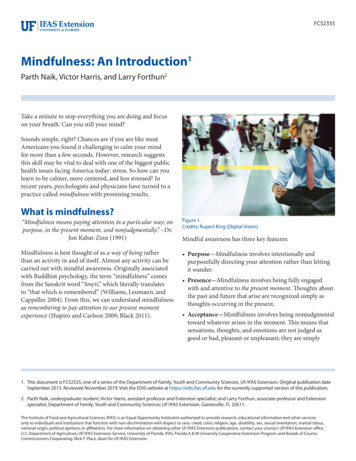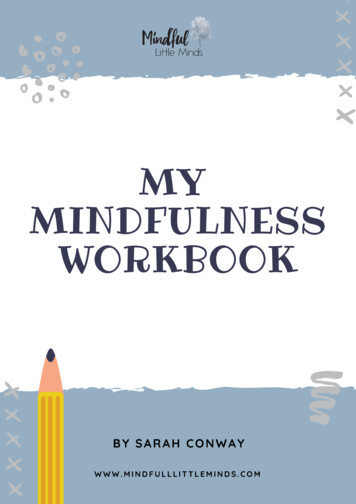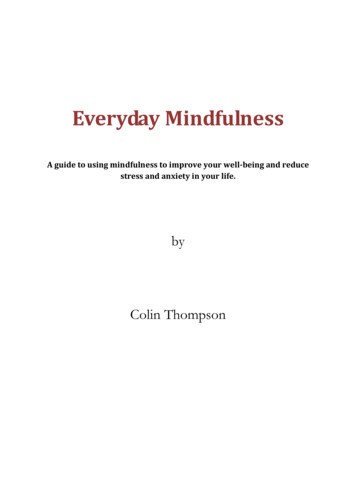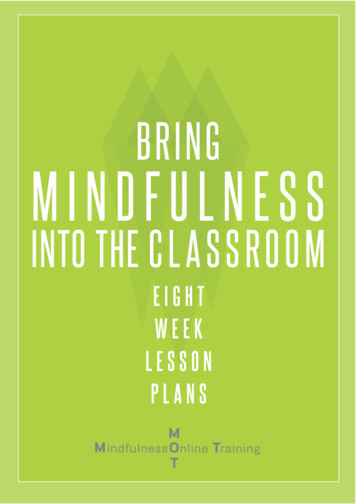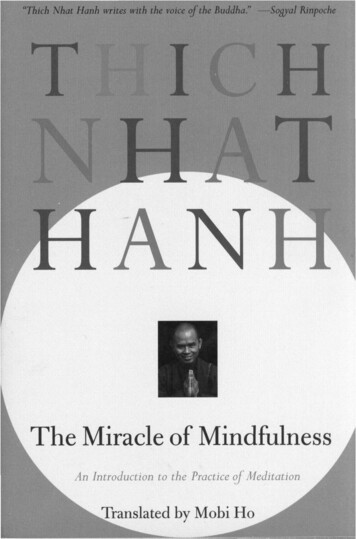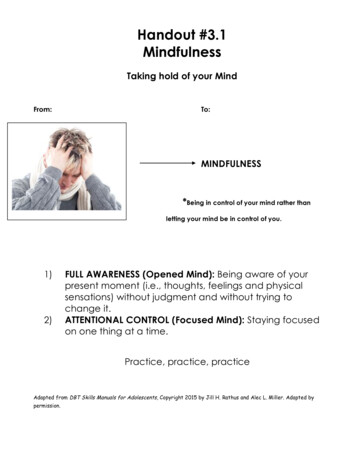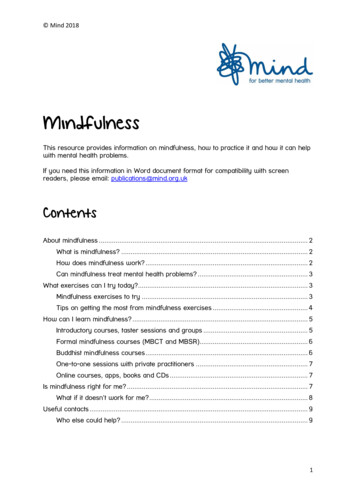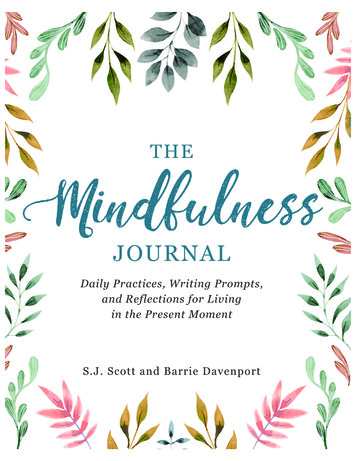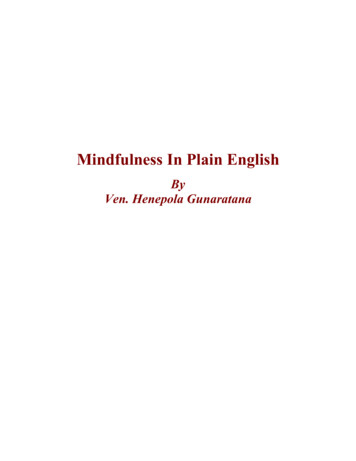
Transcription
Mindfulness In Plain EnglishByVen. Henepola Gunaratana
PrefaceIn my experience I found that the most effective way to express something in order tomake others understand is to use the simplest language. Also I learned from teaching thatthe more rigid the language the less effective it is. People to not respond to very stern andrigid language especially when we try to teach something which normally people don'tengage in during their daily life. Meditation appears to them as something that theycannot always do. As more people turn to meditation, they need more simplifiedinstructions so they can practice by themselves without a teacher around. This book is theresult of requests made by many meditators who need a very simple book written inordinary colloquial language.In preparing this book I have been helped by many of my friends. I am deeply grateful toall of them. Especially I would like to express my deepest appreciation and sinceregratitude to John Patticord, Daniel J. Olmsted, Matthew Flickstein, Carol Flickstein,Patrick Hamilton, Genny Hamilton, Bill Mayne, Bhikkhu Dang Pham Jotika and BhikkhuSona for their most valuable suggestions, comments and criticisms of numerous points inpreparing this book. Also thanks to Reverend Sister Sama and Chris O'Keefe for theirsupport in production efforts.2
About the AuthorVenerable Henepola Gunaratana was ordained at the age of 12 as a Buddhist monk at asmall temple in Malandeniya Village in Kurunegala District in Sri Lanka. His preceptorwas Venerable Kiribatkumbure Sonuttara Mahathera. At the age of 20 he was givenhigher ordination in Kandy in 1947. He received his education from VidyalankaraCollege and Buddhist Missionary College in Colombo. Subsequently he traveled to Indiafor five years of missionary work for the Mahabodhi Society, serving the Harijana(Untouchable) people in Sanchi, Delhi, and Bombay. Later he spent ten years as amissionary in Malaysia, serving as religious advisor to the Sasana AbhivurdhiwardhanaSociety, Buddhist Missionary Society and the Buddhist Youth Federation of Malaysia.He has been a teacher in Kishon Dial School and Temple Road Girls' School andPrincipal of the Buddhist Institute of Kuala Lumppur.At the invitation of the Sasana Sevaka Society, Venerable Gunaratana came to the UnitedStates in 1968 to serve as Hon. General Secretary of the Buddhist Vihara Society ofWashington, D.C. In 1980 he was appointed President of the Society. During his years atthe Vihara, he has taught courses in Buddhism, conducted meditation retreats, andlectured widely throughout the United States, Canada, Europe, Australia and NewZealand.He has also pursued his scholarly interests by earning a B.A., and M.A., and a Ph.D. inPhilosophy from the American University. He taught courses in Buddhism at theAmerican University, Georgetown University and University of Maryland. His books andarticles have been published in Malaysia, India, Sri Lanka and the United States.Since 1973 he has been buddhist chaplin at The American University counseling studentsinterested in Buddhism and Buddhist meditation. He is now president of the BhavanaSociety in West Virginia in the Shenandoah Valley, about 100 miles from Washington,D.C. teaching meditation and conducting meditation retreats.3
IntroductionAmerican BuddhismThe subject of this book is Vipassana meditation practice. Repeat, practice. This is ameditation manual, a nuts-and-bolts, step-by-step guide to Insight meditation. It is meantto be practical. It is meant for use.There are already many comprehensive books on Buddhism as a philosophy, and on thetheoretical aspects of Buddhist meditation. If you are interested in that material we urgeyou to read those books. Many of them are excellent. This book is a 'How to.' It is writtenfor those who actually want to meditate and especially for those who want to start now.There are very few qualified teachers of the Buddhist style of meditation in the UnitedStates of America. It is our intention to give you the basic data you need to get off to aflying start. Only those who follow the instructions given here can say whether we havesucceeded or failed. Only those who actually meditate regularly and diligently can judgeour effort. No book can possibly cover every problem that a meditator may run into. Youwill need to meet a qualified teacher eventually. In the mean time, however, these are thebasic ground rules; a full understanding of these pages will take you a very long way.There are many styles of meditation. Every major religious tradition has some sort ofprocedure which they call meditation, and the word is often very loosely used. Pleaseunderstand that this volume deals exclusively with the Vipassana style of meditation astaught and practiced in South and Southeast Asian Buddhism. It is often translated asInsight meditation, since the purpose of this system is to give the meditator insight intothe nature of reality and accurate understanding of how everything works.Buddhism as a whole is quite different from the theological religions with whichWesterners are most familiar. It is a direct entrance to a spiritual or divine realm withoutaddressing deities or other 'agents'. Its flavor is intensely clinical, much more akin towhat we would call psychology than to what we would usually call religion. It is an everongoing investigation of reality, a microscopic examination of the very process ofperception. Its intention is to pick apart the screen of lies and delusions through which wenormally view the world, and thus to reveal the face of ultimate reality. Vipassanameditation is an ancient and elegant technique for doing just that.Theravada Buddhism presents us with an effective system for exploring the deeper levelsof the mind, down to the very root of consciousness itself. It also offers a considerablesystem of reverence and ritual in which those techniques are contained. This beautifultradition is the natural result of its 2,500-year development within the highly traditionalcultures of South and Southeast Asia.In this volume, we will make every effort to separate the ornamental from thefundamental and to present only the naked plain truth itself. Those readers who are of aritualistic bent may investigate the Theravada practice in other books, and will find therea vast wealth of customs and ceremony, a rich tradition full of beauty and significance.4
Those of a more clinical bent may use just the techniques themselves, applying themwithin whichever philosophical and emotional context they wish. The practice is thething.The distinction between Vipassana meditation and other styles of meditation is crucialand needs to be fully understood. Buddhism addresses two major types of meditation.They are different mental skills, modes of functioning or qualities of consciousness. InPali, the original language of Theravada literature, they are called 'Vipassana' and'Samatha'.'Vipassana' can be translated as 'insight', a clear awareness of exactly what is happeningas it happens. 'Samatha' can be translated as 'concentration' or 'tranquility'. It is a state inwhich the mind is brought to rest, focused only on one item and not allowed to wander.When this is done, a deep calm pervades body and mind, a state of tranquility which mustbe experienced to be understood. Most systems of meditation emphasize the Samathacomponent. The meditator focuses his mind upon some items, such as prayer, a certaintype of box, a chant, a candle flame, a religious image or whatever, and excludes all otherthoughts and perceptions from his consciousness. The result is a state of rapture whichlasts until the meditator ends the session of sitting. It is beautiful, delightful, meaningfuland alluring, but only temporary. Vipassana meditation addresses the other component,insight.The Vipassana meditator uses his concentration as a tool by which his awareness can chipaway at the wall of illusion which cuts him off from the living light of reality. It is agradual process of ever-increasing awareness of the inner workings of reality itself. Ittakes years, but one day the meditator chisels through that wall and tumbles into thepresence of light. The transformation is complete. It's called liberation, and it'spermanent. Liberation is the goal of all buddhist systems of practice. But the routes toattainment of the end are quite diverse.There are an enormous number of distinct sects within Buddhism. But they divide intotwo broad streams of thought -- Mahayana and Theravada. Mahayana Buddhism prevailsthroughout East Asia, shaping the cultures of China, Korea, Japan, Nepal, Tibet andVietnam. The most widely known of the Mahayana systems is Zen, practiced mainly inJapan, Korea, Vietnam and the United States. The Theravada system of practice prevailsin South and Southeast Asia in the countries of Sri Lanka, Thailand, Burma, Laos andCambodia. This book deals with Theravada practice.The traditional Theravada literature describes the techniques of both Samatha(concentration and tranquility of mind) and Vipassana (insight or clear awareness). Thereare forty different subjects of meditation described in the Pali literature. They arerecommended as objects of concentration and as subjects of investigation leading toinsight. But this is a basic manual, and we limit our discussion to the most fundamental ofthose recommended objects--breathing. This book is an introduction to the attainment ofmindfulness through bare attention to, and clear comprehension of, the whole process ofbreathing. Using the breath as his primary focus of attention, the meditator applies5
participatory observation to the entirety of his own perceptual universe. He learns towatch changes occurring in all physical experiences, in feelings and in perceptions. Helearns to study his own mental activities and the fluctuations in the character ofconsciousness itself. All of these changes are occurring perpetually and are present inevery moment of our experience.Meditation is a living activity, an inherently experiential activity. It cannot be taught as apurely scholastic subject. The living heart of the process must come from the teacher'sown personal experience. Nevertheless, there is a vast fund of codified material on thesubject which is the product of some of the most intelligent and deeply illumined humanbeings ever to walk the earth. This literature is worthy of attention. Most of the pointsgiven in this book are drawn from the Tipitaka, which is the three-section collected workin which the Buddha's original teachings have been preserved. The Tipitaka is comprisedof the Vinaya, the code of discipline for monks, nuns, and lay people; the Suttas, publicdiscourses attributed to the Buddha; and the Abhidhamma, a set of deep psychophilosophical teachings.In the first century after Christ, an eminent Buddhist scholar named Upatissa wrote theVimuttimagga, (The Path of Freedom) in which he summarized the Buddha's teachingson meditation. In the fifth century A.C. (after Christ,) another great Buddhist scholarnamed Buddhaghosa covered the same ground in a second scholastic thesis--theVisuddhimagga, (The Path of Purification) which is the standard text on meditation eventoday. Modern meditation teachers rely on the Tipitaka and upon their own personalexperiences. It is our intention to present you with the clearest and most concisedirections for Vipassana meditation available in the English language. But this bookoffers you a foot in the door. It's up to you to take the first few steps on the road to thediscovery of who you are and what it all means. It is a journey worth taking. We wishyou success.6
Chapter 1Meditation: Why Bother?Meditation is not easy. It takes time and it takes energy. It also takes grit, determinationand discipline. It requires a host of personal qualities which we normally regard asunpleasant and which we like to avoid whenever possible. We can sum it all up in theAmerican word 'gumption'. Meditation takes 'gumption'. It is certainly a great deal easierjust to kick back and watch television. So why bother? Why waste all that time andenergy when you could be out enjoying yourself? Why bother? Simple. Because you arehuman. And just because of the simple fact that you are human, you find yourself heir toan inherent unsatisfactoriness in life which simply will not go away. You can suppress itfrom your awareness for a time. You can distract yourself for hours on end, but it alwayscomes back--usually when you least expect it. All of a sudden, seemingly out of the blue,you sit up, take stock, and realize your actual situation in life.There you are, and you suddenly realize that you are spending your whole life just barelygetting by. You keep up a good front. You manage to make ends meed somehow andlook OK from the outside. But those periods of desperation, those times when you feeleverything caving in on you, you keep those to yourself. You are a mess. And you knowit. But you hide it beautifully. Meanwhile, way down under all that you just know therehas got be some other way to live, some better way to look at the world, some way totouch life more fully. You click into it by chance now and then. You get a good job. Youfall in love. You win the game. and for a while, things are different. Life takes on arichness and clarity that makes all the bad times and humdrum fade away. The wholetexture of your experience changes and you say to yourself, "OK, now I've made it; now Iwill be happy". But then that fades, too, like smoke in the wind. You are left with just amemory. That and a vague awareness that something is wrong.But there is really another whole realm of depth and sensitivity available in life,somehow, you are just not seeing it. You wind up feeling cut off. You feel insulated fromthe sweetness of experience by some sort of sensory cotton. You are not really touchinglife. You are not making it again. And then even that vague awareness fades away, andyou are back to
mindfulness through bare attention to, and clear comprehension of, the whole process of breathing. Using the breath as his primary focus of attention, the meditator applies 5 . participatory observation to the entirety of his own perceptual universe. He learns to watch changes occurring in all physical experiences, in feelings and in perceptions. He learns to study his own mental activities .File Size: 650KBPage Count: 104

